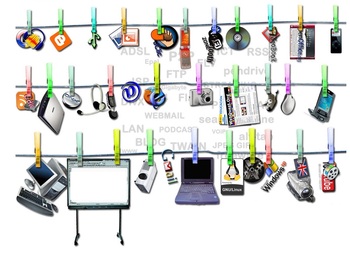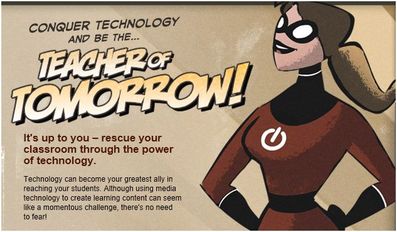What Does "Technology Integration" Mean?
What do we really mean when we talk about “technology integration?” The term means that technology is not
taught as a separate class, but integrated into the classroom. It also means that students use technology to learn content and show their understanding of content, not just their expertise with a tool.
However, how do we get to that point? Despite the popularity of the term “digital native,” we should not assume that our students know how to use technology to create quality projects that show deep understanding of content.
Therefore, technology integration may not look the way we want it to until our students move beyond familiarity with tools and into being able to choose the correct tool for the job. As I stated in my previous post, it takes time for students to become familiar enough with a tool to really employ it for learning beyond the tool itself. However, if we
take the time to let our students explore tools with guided practice, we can ensure that your classroom will move toward true integration.
I see various levels of integration, with the ultimate goal being seamless integration.
This table is simply a starting point to think about how technology integration looks in your own classroom. In addition, your classroom may move through these levels over the course of the year.
What do we really mean when we talk about “technology integration?” The term means that technology is not
taught as a separate class, but integrated into the classroom. It also means that students use technology to learn content and show their understanding of content, not just their expertise with a tool.
However, how do we get to that point? Despite the popularity of the term “digital native,” we should not assume that our students know how to use technology to create quality projects that show deep understanding of content.
Therefore, technology integration may not look the way we want it to until our students move beyond familiarity with tools and into being able to choose the correct tool for the job. As I stated in my previous post, it takes time for students to become familiar enough with a tool to really employ it for learning beyond the tool itself. However, if we
take the time to let our students explore tools with guided practice, we can ensure that your classroom will move toward true integration.
I see various levels of integration, with the ultimate goal being seamless integration.
This table is simply a starting point to think about how technology integration looks in your own classroom. In addition, your classroom may move through these levels over the course of the year.
To Get to "SEAMLESS", You Must Ask Yourself:
What skills are applied to nearly all tools? (i.e. saving a file, naming a file, finding a file)
-How many different tools will you introduce this year? (How many is too many?)
-How will technology help your students better understanding content--will it push them to deeper understanding?
-What level of integration do you want in your classroom by the end of the school year?
Of course, you often do not have a choice about how integrated our classrooms are due to lack of availability. At what level of integration is your classroom? How would you define levels of technology integration?
-How many different tools will you introduce this year? (How many is too many?)
-How will technology help your students better understanding content--will it push them to deeper understanding?
-What level of integration do you want in your classroom by the end of the school year?
Of course, you often do not have a choice about how integrated our classrooms are due to lack of availability. At what level of integration is your classroom? How would you define levels of technology integration?
Why Collaborate in the Classroom through Blending Learning?
It is designed to complement classroom instruction and engage students in online activities, assignments and discussions that allow for deeper participation inside and outside the classroom.
Blended learning is implemented in a variety of ways, ranging from models in which curriculum is fully online with face-to-face interaction to models in which face-to-face classroom instruction is integrated with online components that extend learning beyond the classroom or school day.
The rapid growth of blended learning has been a catalyst for additional instructional transformation, including:
-Evolving pedagogy in which teachers’ roles include facilitation, student mentoring and differentiating instruction for individual learners,
-Increased flexibility and personalization of students’ learning experiences, and
-Strategic uses of technology as districts tap the capabilities of the learning management systems to support a wider range of instructional programs.
-Educators support online learning because of its unique abilities to provide students with enriched learning experiences, to extend learning beyond the school day, and to support more successful differentiated learning strategies that personalize students’ educational experiences.
Blended learning is implemented in a variety of ways, ranging from models in which curriculum is fully online with face-to-face interaction to models in which face-to-face classroom instruction is integrated with online components that extend learning beyond the classroom or school day.
The rapid growth of blended learning has been a catalyst for additional instructional transformation, including:
-Evolving pedagogy in which teachers’ roles include facilitation, student mentoring and differentiating instruction for individual learners,
-Increased flexibility and personalization of students’ learning experiences, and
-Strategic uses of technology as districts tap the capabilities of the learning management systems to support a wider range of instructional programs.
-Educators support online learning because of its unique abilities to provide students with enriched learning experiences, to extend learning beyond the school day, and to support more successful differentiated learning strategies that personalize students’ educational experiences.
Learning theory = Learning Practice

Our innate beliefs about things like how we think people
learn are often unstated, but serve as the “operating system” upon which we base our instructional decisions in the classroom. Technologies align strongly with the constructivist and social constructivist theories of learning, and therefore will also fit well into classrooms where these theories of learning are embraced. As new technologies push instruction in the classroom in new directions, so does our ability as professional educators push the evolution of educational technologies.
learn are often unstated, but serve as the “operating system” upon which we base our instructional decisions in the classroom. Technologies align strongly with the constructivist and social constructivist theories of learning, and therefore will also fit well into classrooms where these theories of learning are embraced. As new technologies push instruction in the classroom in new directions, so does our ability as professional educators push the evolution of educational technologies.


